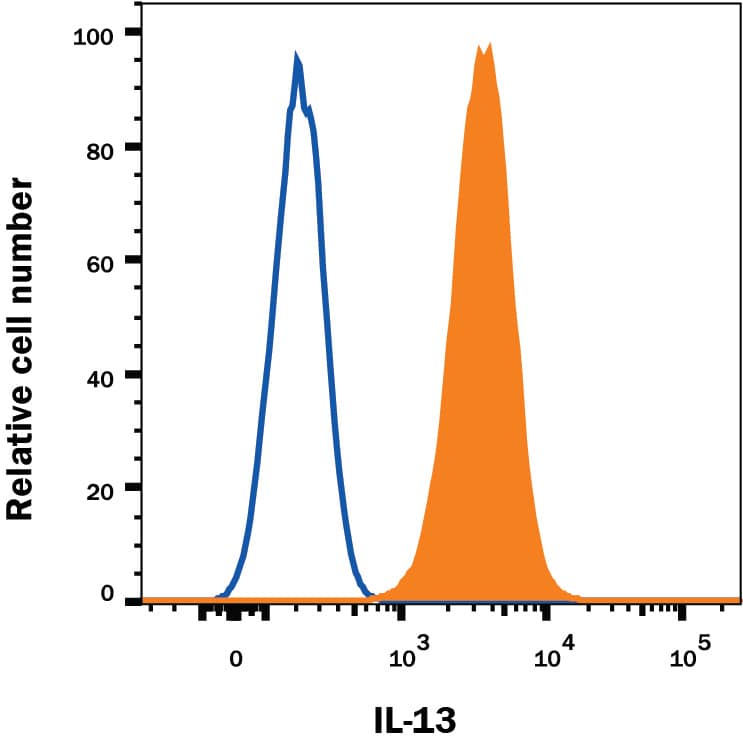Human IL-13 APC-conjugated Antibody
R&D Systems, part of Bio-Techne | Catalog # IC2131A


Key Product Details
Species Reactivity
Applications
Label
Antibody Source
Product Specifications
Immunogen
Gly35-Asn146
Accession # P35225
Specificity
Clonality
Host
Isotype
Scientific Data Images for Human IL-13 APC-conjugated Antibody
Detection of IL‑13 in NS0 Mouse Cell Line Transfected with Human IL-13 by Flow Cytometry.
NS0 mouse myeloma cell line transfected with human IL-13 was stained with Mouse Anti-Human IL-13 APC-conjugated Monoclonal Antibody (Catalog # IC2131A, filled histogram) or isotype control antibody (Catalog # IC002A, open histogram). To facilitate intracellular staining, cells were fixed with Flow Cytometry Fixation Buffer (Catalog # FC004) and permeabilized with Flow Cytometry Permeabilization/Wash Buffer I (Catalog # FC005). View our protocol for Staining Intracellular Molecules.Applications for Human IL-13 APC-conjugated Antibody
Intracellular Staining by Flow Cytometry
Sample: NS0 mouse myeloma cell line transfected with human IL-13 fixed with Flow Cytometry Fixation Buffer (Catalog # FC004) and permeabilized with Flow Cytometry Permeabilization/Wash Buffer I (Catalog # FC005)
Formulation, Preparation, and Storage
Purification
Formulation
Shipping
Stability & Storage
Background: IL-13
IL-13 is a 17 kDa immunoregulatory cytokine that plays a key role in the pathogenesis of allergic asthma and atopy. It is secreted by Th1 and Th2 CD4+ T cells, NK cells, visceral smooth muscle cells, eosinophils, mast cells, and basophils (1-3). IL-13 circulates as a monomer with two internal disulfide bonds that contribute to a bundled four alpha-helix configuration (4, 5). Mature human IL-13 shares 57%, 59%, and 94% amino acid sequence identity with mouse, rat, and rhesus macaque IL-13, respectively. Despite the low homology, it exhibits cross-species activity between human, mouse, and rat (6, 7). IL-13 has diverse activities on numerous cell types (8). On macrophages, IL-13 suppresses the production of pro-inflammatory cytokines and other cytotoxic substances. On B cells, IL-13 induces immunoglobulin class switching to IgE, upregulates the expression of MHC class II, CD71, CD72, and CD23, and costimulates proliferation. IL-13 upregulates IL-6 while downregulating IL-1 and TNF-alpha production by fibroblasts and endothelial cells. IL-13 binds with low affinity to IL-13 R alpha1, triggering IL-13 R alpha1 association with IL-4 R alpha. This high affinity receptor complex also functions as the type 2 IL-4 receptor complex (9, 10). Additionally, IL-13 binds with high affinity to IL-13 R alpha2 which is expressed intracellularly, on the cell surface, and as a soluble molecule (11-14). IL-13 R alpha2 regulates the bioavailability of both IL-13 and IL-4 and is over-expressed in glioma and several bronchial pathologies (10, 15, 16). Compared to wild type IL-13, the atopy-associated R110Q variant of IL-13 elicits increased responsiveness from eosinophils that express low levels of IL-13 R alpha2 (17).
References
- Wills-Karp, M. (2004) Immunol. Rev. 202:175.
- Nakajima H. and K. Takatsu (2007) Int. Arch. Allergy Immunol. 142:265.
- McKenzie, A.N. et al. (1993) Proc. Natl. Acad. Sci. USA 90:3735.
- Moy, F.J. et al. (2001) J. Mol. Biol. 310:219.
- Eisenmesser, E.Z. et al. (2001) J. Mol. Biol. 310:231.
- Ruetten, H. and C. Thiemermann (1997) Shock 8:409.
- Lakkis, F.G. et al. (1997) Biochem. Biophys. Res. Commun. 235:529.
- Wynn, T.A. (2003) Annu. Rev. Immunol. 21:425.
- Andrews, A.L. et al. (2002) J. Biol. Chem. 277:46073.
- Tabata, Y. et al. (2007) Curr. Allergy Asthma Rep. 7:338.
- Chiaramonte, M.G. et al. (2003) J. Exp. Med. 197:687.
- Daines, M.O. and G.K. Hershey (2002) J. Biol. Chem. 227:10387.
- Matsumura, M. et al. (2007) Biochem. Biophys. Res. Commun. 360:464.
- Tabata, Y. et al. (2007) J. Immunol. 177:7905.
- Andrews, A.L. et al. (2006) J. Allergy Clin. Immunol. 118:858.
- Joshi, B.H. et al. (2006) Vitam. Horm. 74:479.
- Andrews, A-L. et al. (2007) J. Allergy Clin. Immunol. 120:91.
Long Name
Alternate Names
Gene Symbol
UniProt
Additional IL-13 Products
Product Documents for Human IL-13 APC-conjugated Antibody
Product Specific Notices for Human IL-13 APC-conjugated Antibody
For research use only